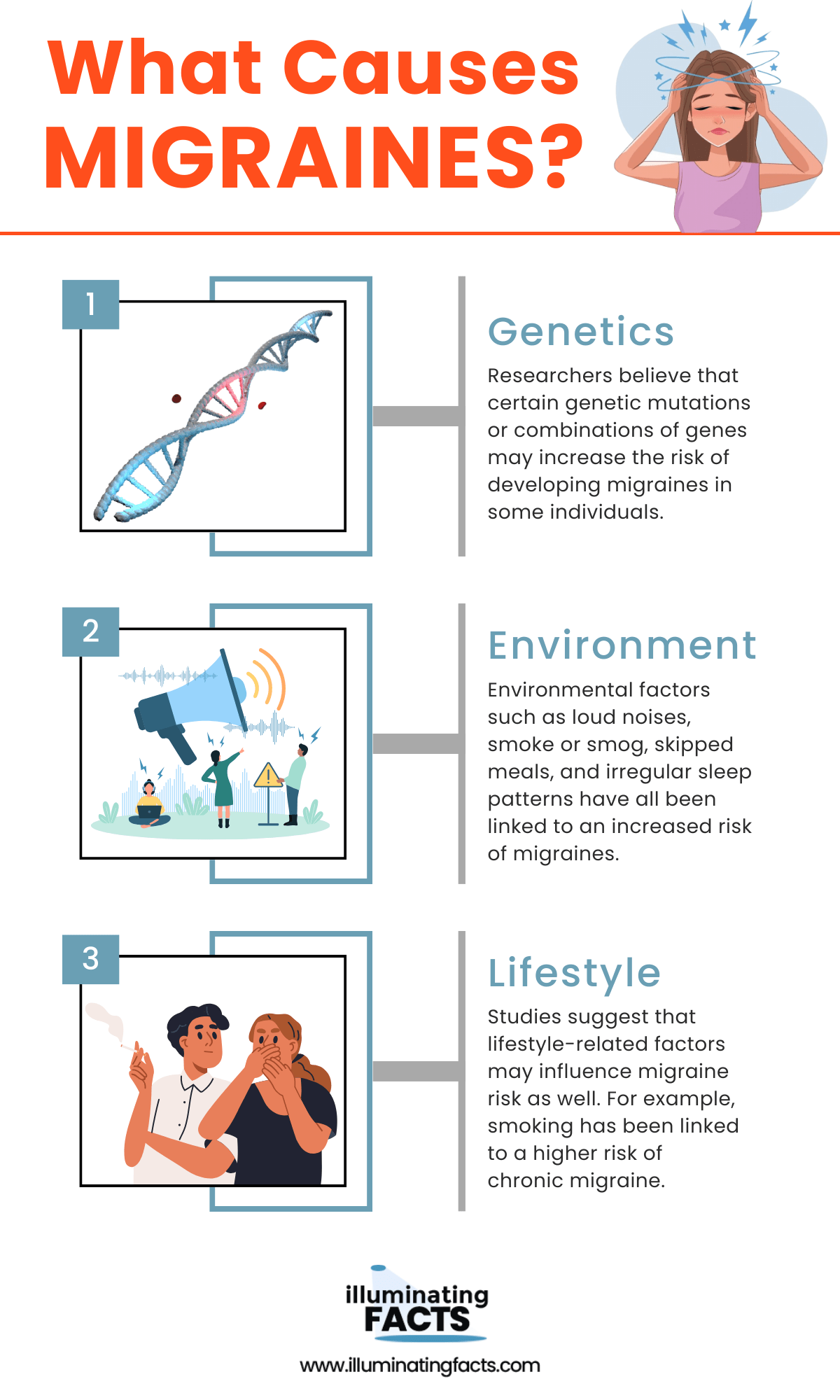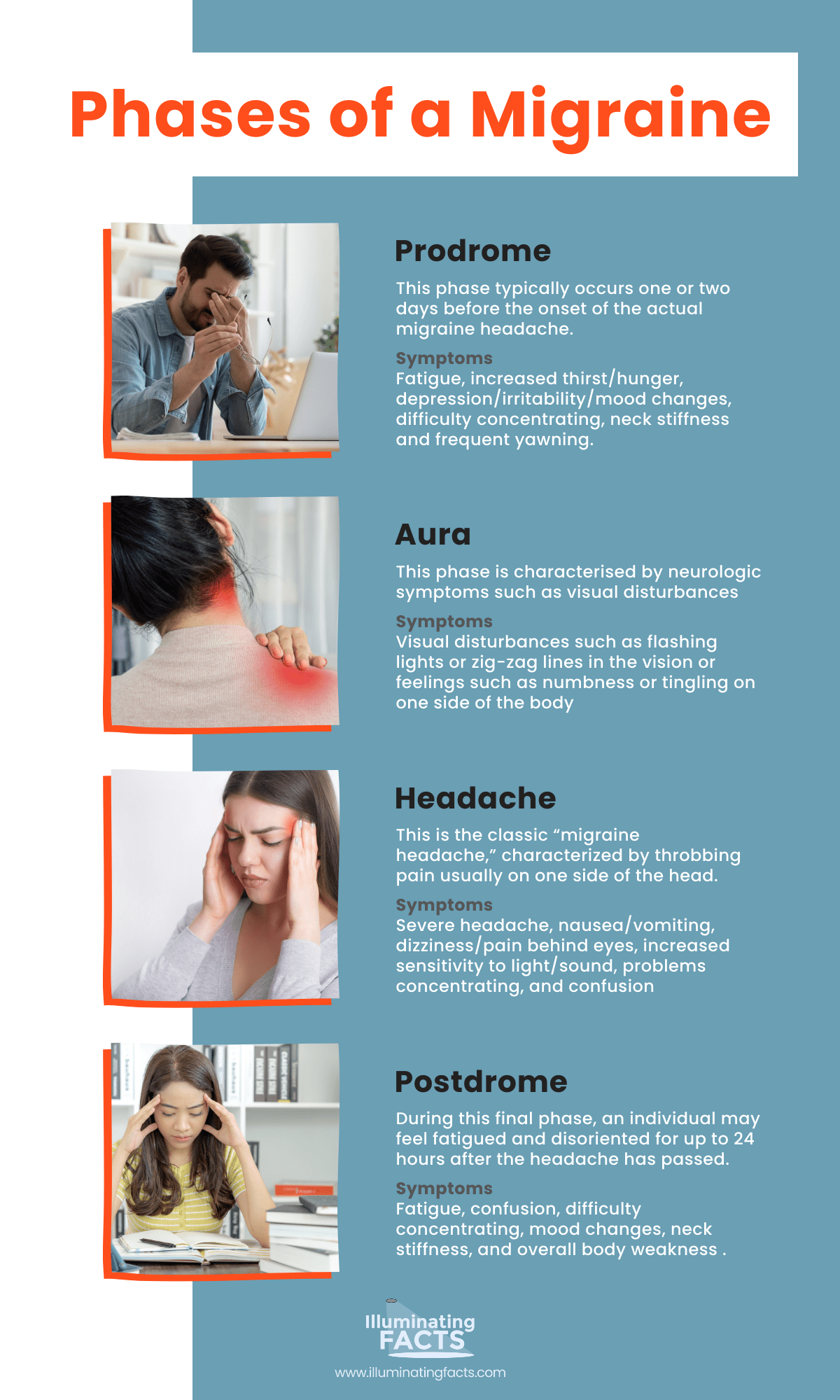Migraine is a debilitating neurological disorder that affects millions of people worldwide. To say that migraines can be a real pain is one way to describe the misery that they bring. But with an estimated 10% of the world’s population affected by them, the medical community knows that it’s not just all in their head. [1] Yet many are not aware of what exactly a migraine is or why it is important to talk about this condition.
Migraine is a neurological disorder that typically causes severe, pulsing or throbbing headaches on one side of the head, accompanied by disturbed vision, sensitivity to light and sound, nausea and vomiting. It can last from a few hours to a few days, depending on the individual, but typically starts gradually and gradually gets worse over time before resolving itself.
For sufferers, understanding what happens during a migraine can help them better manage the condition and make informed decisions about treatment.
What Causes Migraines?
While the exact cause of migraines is still unknown, there are several theories out there as to why they occur and how they can be prevented or treated. Genetics is thought to play a role, as well as environmental factors like stress and changes in weather patterns. Additionally, lifestyle factors such as diet, sleep habits and consuming certain types of foods or beverages can also contribute to migraines.
The most accepted theory is that migraines are caused by a disruption in blood supply to the brain that disturbs the circuits regulating pain and other bodily sensations. This disturbance is thought to change how certain areas of the brain process sensory information. The exact cause of why this happens is not yet known but there are many potential triggers, including genetics, environment, and lifestyle factors.
Genetics
Researchers believe that certain genetic mutations or combinations of genes may increase the risk of developing migraines in some individuals. [2] by making it easier for migraine triggers to cause an attack. Some specific genes associated with migraines have been identified, such as those involved in controlling the narrowing and expansion of blood vessels, [3] or those involved in serotonin production. [4]
These genes could play a role in migraine susceptibility by affecting neurological processes such as pain perception and neurotransmitter release. However, more research is needed to understand the full role genetics plays in migraines.
Environment
Environmental factors such as loud noises, smoke or smog, skipped meals, and irregular sleep patterns have all been linked to an increased risk of migraines. In addition, certain medications and food additives can also trigger migraines in some people.
If you find yourself experiencing frequent or severe migraines, it’s important to pay attention to your environment and identify potential triggers so you can avoid them when possible.
Lifestyle
Studies suggest that lifestyle-related factors may influence migraine risk as well. For example, smoking has been linked to a higher risk of chronic migraine. Regular exercise, on the other hand, may reduce the frequency and intensity of migraine attacks.
Similarly, eating a balanced diet low in sodium and saturated fats and increasing your intake of essential vitamins and minerals may reduce the risk of developing chronic migraine headaches. Thus, it’s important to maintain healthy lifestyle habits as much as possible.
Symptoms of a Migraine
The most frequently reported symptoms of migraines are:
- Headaches
- Nausea
- Dizziness
- Sensitivity to light and sound
Many people also experience an upset stomach or abdominal pain, trouble speaking and understanding words, tingling sensations in the limbs, as well as vision changes, such as blurred vision or blind spots.
Although the list above contains many of the most common symptoms associated with migraines, it is important to note that the symptoms you experience may differ from the ones listed or may be more or less severe. It is also important to remember that everyone’s migraines are unique and will not necessarily manifest in the same way as another’s.
Phases of a Migraine
| Phase | Symptoms |
| Prodrome | Fatigue, increased thirst/hunger, depression/irritability/mood changes, difficulty concentrating, neck stiffness and frequent yawning. |
| Aura | Visual disturbances such as flashing lights or zig-zag lines in the vision or feelings such as numbness or tingling on one side of the body |
| Headache | Severe headache, nausea/vomiting, dizziness/pain behind eyes, increased sensitivity to light/sound, problems concentrating, and confusion |
| Postdrome | Fatigue, confusion, difficulty concentrating, mood changes, neck stiffness, and overall body weakness . |
When someone experiences a migraine, it typically progresses through four distinct phases: prodrome, aura, headache, and postdrome. Let’s take a closer look at what happens during each phase of the migraine:
Prodrome
This phase typically occurs one or two days before the onset of the actual migraine headache. During the prodrome phase, an individual may experience changes in mood or their energy level. They may become excessively hungry or thirsty or experience constipation or other digestive issues. They may also experience neck pain or stiffness and sensitivity to smells or sounds that didn’t previously bother them.
Aura
This phase is characterised by neurologic symptoms such as visual disturbances (like seeing flashes of light), weakness on one side of the body, numbness in the face or extremities, speech difficulties, uncontrollable jerking movements, dizziness and confusion. This phase typically lasts up to an hour before the next phase begins.
Headache
This is the classic “migraine headache,” characterized by throbbing pain usually on one side of the head. This severe condition can be accompanied by sensitivity to light and sound, nausea, vomiting and irritability. The headache phase typically lasts for four to 72 hours before transitioning into the next phase.
Postdrome
During this final phase, an individual may feel fatigued and disoriented for up to 24 hours after the headache has passed. They may also experience difficulty concentrating and memory issues during this time period.
Understanding the different phases associated with a migraine can help individuals better manage their migraines and seek medical advice when necessary. It’s important to note that not everyone experiences all four phases of a migraine. Some people only experience one or two phases each time they have an attack. If you have any questions or concerns about your migraines or any other health issue please consult with your doctor.
What are Common Triggers?
Migraines are often triggered by specific activities or external factors. It is important to be aware of the possible triggers for your migraines so that you can attempt to avoid them.
- Food
Food-related migraine triggers include aged cheeses, processed meats (pepperoni, sausages and bacon), chocolate, citrus fruits, certain nuts and seeds, alcohol (specifically red wine), and MSG (monosodium glutamate).
- Hormonal Triggers
Hormonal changes experienced during the menstrual cycle can also trigger migraines in some individuals.
- Smells
Certain smells, such as perfumes and cleaning products, can cause a migraine episode in those who are sensitive to them.
- Mental Distress
Stress and psychological distress can also trigger a migraine in some people.
- Weather
There is evidence to suggest that weather changes, such as sudden decreases in air pressure or extreme temperatures, may also be potential triggers for migraines.
Do you know what happens when you faint? Find out now.
Who Is More Susceptible?
There are certain populations who are more likely to experience a migraine than others.
- Women are three times more likely than men to experience migraines, possibly due to hormonal fluctuations during menstruation, pregnancy, and menopause. [5]
- If you have a family history i.e. a close relative, such as a parent or sibling, experiences migraines, you may be more likely to develop them as well. [6]
- People with medical conditions such as depression, anxiety, epilepsy, and sleep disorders may be more susceptible to migraines. [7]
- Certain foods, such as chocolate, cheese, and processed meats, can trigger migraines in people who are sensitive to them. [8]
- Other triggers include stress, lack of sleep, bright or flashing lights, and loud noises. [9]
- People who take certain medications: Some medications, such as hormonal contraceptives and blood pressure medications, can increase the likelihood of experiencing migraines. [10]
It’s worth noting that while these factors have been associated with an increased susceptibility to migraines, they do not necessarily cause migraines in every individual who experiences them. Migraines are a complex neurological condition with multiple factors at play, and more research is needed to fully understand their causes and triggers.
How To Manage a Migraine
There are several ways to manage migraines, including medication, lifestyle changes, and alternative therapies. It’s important to note that what works for one person may not work for another, so it may take some time to find the right combination of treatments that works for you.
Medication
There are several types of medications that can be used to treat migraines, including pain-relieving medications such as over-the-counter painkillers like ibuprofen and acetaminophen, as well as prescription medications such as triptans and ergotamines.
Lifestyle Changes
Making certain lifestyle changes can also help manage migraines. These may include:
- Identifying and avoiding triggers: Keeping a headache diary to track triggers, such as stress, lack of sleep, certain foods, and hormonal changes, can help identify and avoid them.
- Establishing a regular sleep schedule: Going to bed and waking up at the same time each day can help regulate sleep and prevent migraines.
- Eating a healthy diet: Eating a diet that is rich in fruits, vegetables, whole grains, and lean protein can help reduce the frequency and severity of migraines.
- Exercising regularly: Regular exercise can help reduce stress and improve overall health, which can help prevent migraines.
- Managing stress: Avoiding stress and practicing relaxation techniques such as yoga, meditation, or deep breathing exercises can prove beneficial in managing a migraine.
Alternative Therapies
Alternative therapies may also be beneficial in managing migraines. Acupuncture, massage, and chiropractic treatments are non-invasive methods that may help reduce the frequency and intensity of migraines. Some people find that taking magnesium supplements or using essential oils such as lavender or peppermint can also be helpful. You can also try herbs like butterbur and feverfew. [11]
Importance of Identifying Triggers and Avoiding Them
One of the most important aspects of managing migraines is identifying triggers and avoiding them. Triggers can vary from person to person, but common ones include stress, certain foods, hormonal changes, and changes in sleep patterns. By keeping a migraine diary and noting when migraines occur and what was happening at the time, it may be possible to identify triggers and avoid them in the future.
When To Seek Medical Attention
While most migraines can be managed at home or with over-the-counter medication, there are certain situations where it is important to seek medical attention. Here are some red flags to watch out for:
- Sudden onset: If you have never experienced migraines before and suddenly develop severe head pain, you should seek medical attention immediately.
- Change in symptoms: If you experience a change in the pattern or severity of your migraines, such as an increase in frequency or a sudden change in the location or type of pain, it may be a sign of a more serious condition.
- Neurological symptoms: If you experience neurological symptoms such as confusion, difficulty speaking, or weakness in one side of the body, it may be a sign of a more serious condition, such as a stroke or meningitis.
- Head injury: If your migraine occurs after a head injury, it is important to seek medical attention to rule out more serious conditions such as a concussion or brain bleed.
Types of Healthcare Professionals Who Can Help
If you suffer from migraines, it’s important to speak with a healthcare professional to develop a personalized treatment plan. They can help you manage your migraines and improve your quality of life. Here are different types of healthcare professionals who can help:
- Primary care physician: Your primary care physician can help diagnose and manage your migraines. They may prescribe medication or recommend lifestyle changes to help prevent and manage your migraines.
- Neurologist: A neurologist specializes in the diagnosis and treatment of neurological conditions, including migraines. They may prescribe medication or recommend alternative therapies to help manage your migraines.
- Headache specialist: A headache specialist is a neurologist who specializes in the treatment of headaches, including migraines. They may be able to offer more specialized care and treatment options.
Treatment
There are several different types of treatments available for migraines including:
Acute Medications
These are medications used to relieve the symptoms of an ongoing migraine attack. Commonly used acute medications include over-the-counter painkillers like ibuprofen and acetaminophen, as well as prescription drugs like triptans, ergotamines, and anti-nausea medications.
Preventive Medications
These are medications used to reduce the frequency and severity of migraine attacks. Preventive medications may include beta-blockers, antidepressants, anticonvulsants, and calcium channel blockers.
Botox Injections
Botox injections have been approved by the FDA as a treatment for chronic migraines. The injections are given every 12 weeks and work by blocking the release of chemicals that contribute to migraine headaches.
Gepants
Gepants are a new class of medication specifically designed to treat acute migraines by blocking the activity of a protein called calcitonin gene-related peptide (CGRP). They are taken orally and can be used by people who cannot tolerate triptans.
Greater Occipital Nerve (GIN) Block Injections
These injections involve injecting a local anesthetic and steroid medication into the greater occipital nerve, which is located at the back of the head. This treatment can be helpful for people who experience frequent migraines and have not responded well to other treatments.
You should work with a healthcare professional to determine the most appropriate treatment for your migraines. They can help you develop a personalized treatment plan that may involve one or more of these approaches.
Interesting Facts
- Migraines affect about 1 billion people worldwide. [12]
- They can last from a few hours to several days.
- Some people experience an “aura” before a migraine, which can include visual disturbances like flashes of light or blind spots.
- People who experience migraines are more likely to have depression and anxiety than those who do not.
- Botox, which is commonly used for cosmetic purposes, has been approved as a treatment for chronic migraines.
- The use of certain types of birth control pills can increase the frequency and severity of migraines in some people.
Do you crack your knuckles? Find out what happens when you do it.
Conclusion
Migraines are a common neurological condition that can cause significant pain and disability. They can last for hours or days and can be triggered by a variety of factors, including stress, lack of sleep, certain foods, changes in weather, and hormonal changes.
Effective migraine management involves identifying triggers and avoiding them, making lifestyle changes, and using medications or alternative therapies to relieve symptoms and prevent future attacks. There are various types of medications available, including acute medications used during an ongoing migraine attack and preventive medications used to reduce the frequency and severity of attacks. Alternative therapies like acupuncture, biofeedback, or massage may also be helpful.
While migraines cannot be cured, with proper management and treatment, it’s possible to reduce the frequency and severity of attacks and improve quality of life.
References
- Patient information: Migraine. (2022, January 4). JAMA Network | Home of JAMA and the Specialty Journals of the American Medical Association. https://jamanetwork.com/journals/jama/fullarticle/2787727
- Exploring the hereditary nature of migraine. (n.d.). PubMed Central (PMC). https://www.ncbi.nlm.nih.gov/pmc/articles/PMC8075356/
- Migraine: MedlinePlus genetics. (n.d.). MedlinePlus – Health Information from the National Library of Medicine. https://medlineplus.gov/genetics/condition/migraine/#causes
- Serotonin and migraine: A reconsideration of the central theory. (2008, July 31). BioMed Central. https://thejournalofheadacheandpain.biomedcentral.com/articles/10.1007/s10194-008-0058-2
- Process evaluation of child health services at outreach sites during health and nutrition day (Mamta day) in urban slums of western India. (2017, April). PubMed Central (PMC). https://www.ncbi.nlm.nih.gov/pmc/articles/PMC5749095/
- Migraine and its psychiatric comorbidities. (2016, July 1). Journal of Neurology, Neurosurgery & Psychiatry. https://jnnp.bmj.com/content/87/7/741
- Americanmigrainefoundation.org. (n.d.). americanmigrainefoundation.org | 520: Web server is returning an unknown error. https://americanmigrainefoundation.org/resource-library/who-gets-migraine/
- Americanmigrainefoundation.org. (n.d.). americanmigrainefoundation.org | 520: Web server is returning an unknown error. https://americanmigrainefoundation.org/resource-library/food-and-migraine/
- Cyberbullying victimization, self-esteem and suicidal ideation in adolescence: Does emotional intelligence play a buffering role? (n.d.). PubMed Central (PMC). https://www.ncbi.nlm.nih.gov/pmc/articles/PMC5874900/
- Behavioral and Other Nonpharmacologic Treatments for Headache. (2014, May 2). https://headachejournal.onlinelibrary.wiley.com. https://headachejournal.onlinelibrary.wiley.com/doi/full/10.1111/head.12369
- Dietary supplements for headaches: What the science says. (n.d.). NCCIH. https://www.nccih.nih.gov/health/providers/digest/dietary-supplements-for-headaches-science
- Migraine: A review on its history, global epidemiology, risk factors, and comorbidities. (n.d.). PubMed Central (PMC). https://www.ncbi.nlm.nih.gov/pmc/articles/PMC8904749/





